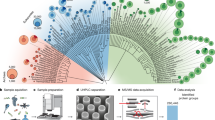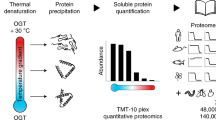Abstract
A set of 424 nonmembrane proteins from Methanobacterium thermoautotrophicum were cloned, expressed and purified for structural studies. Of these, ∼20% were found to be suitable candidates for X-ray crystallographic or NMR spectroscopic analysis without further optimization of conditions, providing an estimate of the number of the most accessible structural targets in the proteome. A retrospective analysis of the experimental behavior of these proteins suggested some simple relations between sequence and solubility, implying that data bases of protein properties will be useful in optimizing high throughput strategies. Of the first 10 structures determined, several provided clues to biochemical functions that were not detectable from sequence analysis, and in many cases these putative functions could be readily confirmed by biochemical methods. This demonstrates that structural proteomics is feasible and can play a central role in functional genomics.
This is a preview of subscription content, access via your institution
Access options
Subscribe to this journal
Receive 12 print issues and online access
$189.00 per year
only $15.75 per issue
Buy this article
- Purchase on Springer Link
- Instant access to full article PDF
Prices may be subject to local taxes which are calculated during checkout




Similar content being viewed by others
References
Zarembinski, T.I., et al. Structure-based assignment of the biochemical function of a hypothetical protein: a test case of structural genomics. Proc. Natl. Acad. Sci. USA 95, 15189–15193 (1998).
Montelione, G.T. & Anderson, S. Structural genomics: keystone for a human proteome project. Nature Struct. Biol. 6, 11–12 (1999).
Gerstein, M. & Hegyi, H. Comparing microbial genomes in terms of protein structure: surveys of a finite parts list. FEMS Microbiol. Rev. 22, 277 (1998).
Sali, A. 100,000 protein structures for the biologist. Nature Struct. Biol. 5, 1029–1032 (1998).
Sanchez, R. & Sali, A. Large-scale protein structure modeling of the Saccharomyces cerevisiae genome. Proc. Natl. Acad. Sci. USA 95, 13597–13602 (1998).
Moult, J., Hubbard, T., Bryant, S.H., Fidelis, K. & Pedersen, J.T. Critical assessment of methods of protein structure prediction (CASP): round II. Proteins Suppl, 2–6 (1997).
Smith, D.R., et al. Complete genome sequence of Methanobacterium thermoautotrophicum deltaH: functional analysis and comparative genomics. J. Bacteriol. 179, 7135–7155 ( 1997).
Alexander, P., Fahnestock, S., Lee, T., Orban, J. & Bryan, P. Thermodynamic analysis of the folding of the streptococcal protein G IgG-binding domains B1 and B2: why small proteins tend to have high denaturation temperatures. Biochemistry 31, 3597–3603 (1992).
Myers, J.K., Pace, C.N. & Scholtz, J.M. Denaturant m values and heat capacity changes: relation to changes in accessible surface areas of protein unfolding. Protein Sci. 4, 2138–2148 ( 1995).
Quinlan, J.R. Decision trees and decision making. IEEE Transaction on Systems, Man and Cybernetics 20 (1992).
Hendrickson, W.A., Smith, J.L. & Sheriff, S. Direct phase determination based on anomalous scattering . Methods Enzymol. 115, 41– 55 (1985).
Murzin, A.G., Brenner, S.E., Hubbard, T. & Chothia, C. SCOP: a structural classification of proteins database for the investigation of sequences and structures. J. Mol. Biol. 247, 536–540 (1995).
Gerstein, M. & Levitt, M. Comprehensive assessment of automatic structural alignment against a manual standard, the scop classification of proteins. Protein Sci. 7, 445– 456 (1998).
Holm, L. & Sander, C. Protein structure comparison by alignment of distance matrices. J. Mol. Biol. 233, 123–138 (1993).
Raffaelli, N., et al. Identification of the archaeal NMN adenylytransferase gene . Mol. Cell. Biochem. 193, 99– 102 (1999).
Cort, J.R., Yee, A., Edwards, A.M., Arrowsmith, C.H. & Kennedy, M.A. Structure-based functional classification of hypothetical protein MT538 from Methanobacterium thermoautotrophicum. J. Mol. Biol. in the press (2000).
Feher, V.A. & Cavanagh, J. Millisecond-timescale motions contribute to the function of the bacterial response regulator protein Spo0F. Nature 400, 289–293 ( 1999).
O'Hara, B.P., et al. Crystal structure and induction mechanism of AmiC-AmiR: a ligand-regulated transcription antitermination complex. EMBO J. 18, 5175–5186 ( 1999).
Wu, N., Mo, Y., Gao, J. & Pai, E.F. Electrostatic stress in catalysis: structure and mechanism of the enzyme orotidine monophosphate decarboxylase. Proc. Natl. Acad. Sci. USA 97, 2017–2022 (2000).
Mackereth, C.D., Arrowsmith, C.H., Edwards, A.M. & McIntosh, L.P. Zinc-bundle structure of the essential RNA polymerase subunit RPB10 from Methanobacterium thermoautotrophicum. Proc. Natl. Acad. Sci. USA 97, 6316–6321 ( 2000).
Cramer, P., et al. Architecture of RNA polymerase II and implications for the transcription mechanism. Science 288, 640 –649 (2000).
Yee, A., et al. Solution structure of the RNA polymerase subunit RPB5 from Methanobacterium thermoautotrophicum. Proc. Natl. Acad. Sci. USA 97, 6311–6315 ( 2000).
Liu, H., et al. TFAR19, a novel apoptosis-related gene cloned from human leukemia cell line TF-1, could enhance apoptosis of some tumor cells induced by growth factor withdrawal. Biochem. Biophys. Res. Commun. 254 , 203–210 (1999).
Rost, B. & Sander, C. Prediction of protein secondary structure at better than 70% accuracy. J. Mol. Biol. 232, 584–599 (1993).
Kozlov, G., et al. Rapid fold and strcuture determination of the archaeal translation elongation factor 1b from Methanobacterium thermoautotrophicum. J. Biomol. NMR 17, 187–194 (2000).
Perez, J.M. et al. The solution structure of the guanine nucleotide exchange domain of human elongation factor 1β reveals a striking resemblance to that of EF-Ts from Escherichia coli. Structure Fold. Des. 7, 217–226 ( 1999).
Sonnhammer, E.L.L., von Heijne, G. & Krogh, A. A hidden Markov model for predicting transmembrane helices in protein sequences. In Proceedings of the Sixth International Conference on Intelligent Systems for Molecular Biology (eds. Glasgow, J., et al.) 175–182 (AAAI Press, Menlo Park, California; 1998).
Altschul, S.F., Gish, W., Miller, W., Myers, E.W. & Lipman, D.J. Basic local alignment search tool. J. Mol. Biol. 215, 403–410 ( 1990).
Quinlan, J.R. C4.5: Programs for Machine Learning (Morgan Kaufmann, San Mateo, California; 1992).
Acknowledgements
We are grateful to J. Reeve for providing M.th. ΔH chromosomal DNA. We thank technicians, A. Engel, S. Beasely, B. Le and summer students F. Hsu, A. Tuite, G. Minoo, S. Fung J. Loo, and H. Javidni for help with protein expression and purification. We thank L. Daniels for a gift of coenzyme F420, and A. Ayed for performing the EMSA of MTH1615. We acknowledge funding support from the Canadian funding organizations, MRC/CIHR (C.H.A, A.M.E, V.B., K.G.), NSERC (C.D.M), PENCE (L.P.M., E.F.P.) and US DOE contracts (M.A.K., J.R.C.), NIH and the Keck Foundation (M.G.), PNNL Laboratory Director's Research and Development funds (M.A.K.) and a Sloan Foundation-DOE fellowship (Y.K.). Part of the NMR work was performed at EMSL (a national scientific users facility sponsored by DOE Biological and Environmental Research) located at PNNL and operated by Battelle. X-ray data were collected at the Advanced Photon Source supported by the U.S. DOE, Basic Energy Sciences, Office of Science, and BioCARS Sector 14 supported by the NIH.
Author information
Authors and Affiliations
Corresponding authors
Rights and permissions
About this article
Cite this article
Christendat, D., Yee, A., Dharamsi, A. et al. Structural proteomics of an archaeon. Nat Struct Mol Biol 7, 903–909 (2000). https://doi.org/10.1038/82823
Received:
Accepted:
Issue Date:
DOI: https://doi.org/10.1038/82823
This article is cited by
-
Biochemical characterization and synthetic application of aromatic l-amino acid decarboxylase from Bacillus atrophaeus
Applied Microbiology and Biotechnology (2021)
-
Theory and applications of differential scanning fluorimetry in early-stage drug discovery
Biophysical Reviews (2020)
-
The NT11, a novel fusion tag for enhancing protein expression in Escherichia coli
Applied Microbiology and Biotechnology (2019)
-
CAP modifies the structure of a model protein from thermophilic bacteria: mechanisms of CAP-mediated inactivation
Scientific Reports (2018)
-
fDETECT webserver: fast predictor of propensity for protein production, purification, and crystallization
BMC Bioinformatics (2017)



